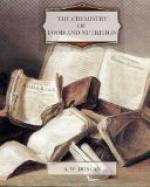It is difficult to determine how much of a food is unassimilated in the body. This is for the reason of the intestinal refuse consisting not only of undigested food, but also of residues of the digestive juices, mucus and epithelial debris. These latter have been shown to amount to from one-third to one-half of the whole of the faeces, which is much more than had previously been supposed.
John Goodfellow has shown that of very coarse wholemeal bread quite 14 per cent. was undigested, whilst bread made from ordinary grade wholemeal showed 12.5 per cent. Such a method of analysis was adopted as it was believed would exclude other than the food waste. The experiments were made on a person who was eating nothing but the bread. It seems probable that a smaller proportion would have remained unassimilated had the bread not formed the sole food. It is advisable that wheatmeal he ground as finely as possible, the coarse is not only to a less extent assimilated but apt to irritate the bowels. Notwithstanding that fine white bread gave only 4.2 per cent. and a coarse white bread 4.9 per cent. of waste, a fine wheatmeal bread is more economical as the same quantity of wheat produces a greater weight of flour richer in proteid and mineral matter. From a large number of experiments with man, it has been calculated that of proteids there is digested when animal food is eaten 98 per cent., from cereals and sugars 8 per cent., from vegetables and fruits 80 per cent. The difference between the proportions digested of the other food constituents was much less. Although there is here a theoretical advantage in favour of animal food, there are other considerations of far more importance than a little undigestible waste. The main question is one of health. In some dietary experiments of a girl aged 7, living upon a fruit diet, of whom we have given some particulars elsewhere, Professor Jaffa gives the following particulars. During the ten days trial the percentages absorbed were proteids 82.5, fat 86.9, nitrogen free extract 96, crude fibre 80, ash 5.7, heat of combustion in calories 86.7. He says, “generally speaking, the food was quite thoroughly assimilated, the coefficients of digestibility being about the same as are found in an ordinary mixed diet. It is interesting to note that 80 per cent. of the crude fibre appeared to be digested. The results of a number of foreign experiments on the digestibility of crude fibre by man are from 30 to 91.4 per cent., the former value being from mixed wheat and rye, and the latter in a diet made of rice, vegetables and meat.”
TABLE OF ANALYSIS OF FOOD
Key:
P = Proteins.
Cb = Carbohydrates.
C = Cellulose.
R = Refuse.
W = Water.
Ca = Calories.




